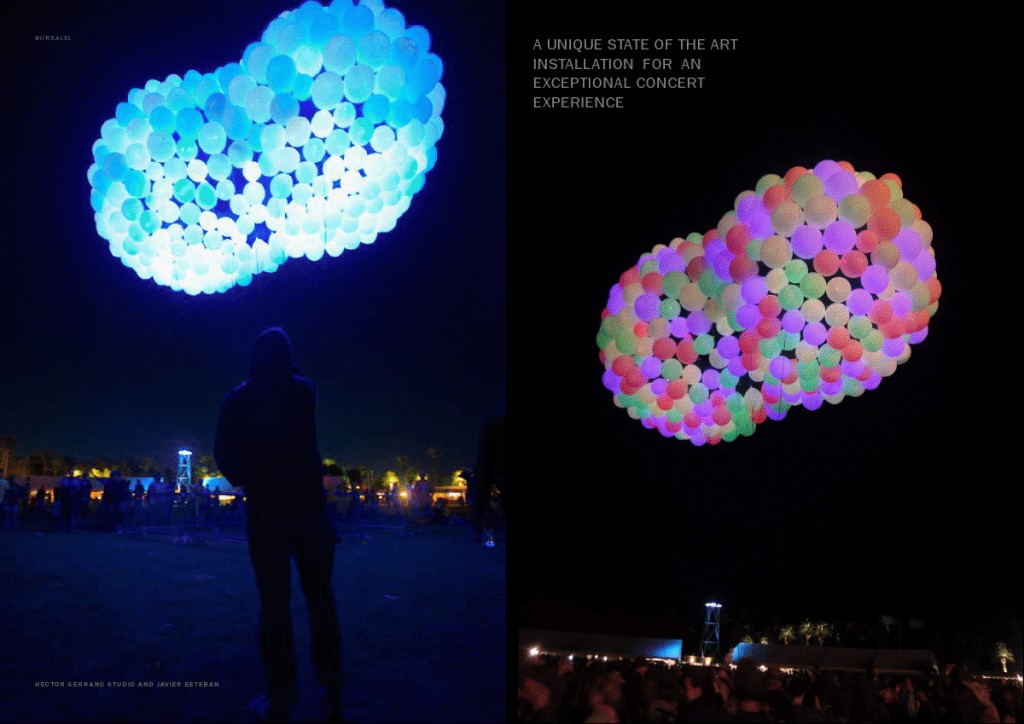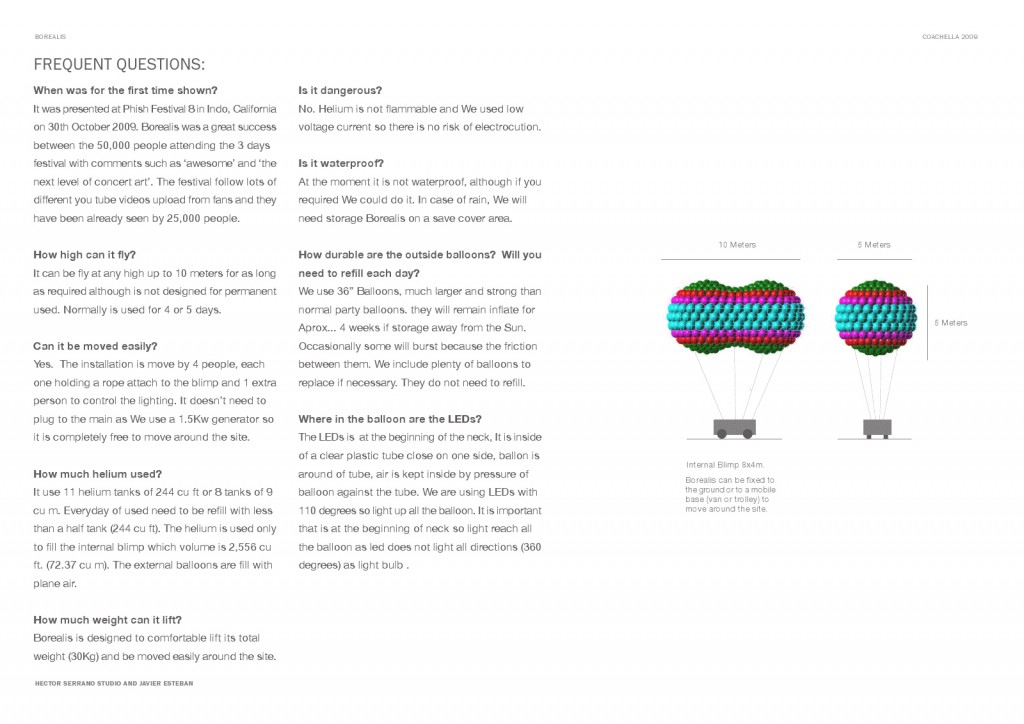The Story Behind PHISH’s Festival 8 “BOREALIS” (lighted sky sculpture)
Last year, the Vermont 4-piece, PHISH triumphantly returned to the stage with a full tour, culminating in a 3-day extravaganza over Halloween weekend, entitled FESTIVAL 8. The event was held at the Empire Polo Grounds in Indio, Ca, where the band played 8 total sets; including one acoustic set and one which featured them covering the Rolling Stones masterpiece Exile on Main St in its entirety, with the assistance of the remarkable Sharon Jones and the Dap Kings. It was an impressive weekend overall, but one thing that really stood out was a lighted sculpture that took flight and boggled the minds of many of us that were in attendance. Being the inquisitive and science/astronomy/technology obsessed little gent that he is, our writer ONSEN took it upon himself to track down the creators of the structure and compile the intriguing and fascinating piece that we have presented below for you. Since it was originally written, the 3-dimensional FESTIVAL 8 film was released in theaters, offering many of you who weren’t in attendance at the actual festival to have the opportunity to get a glimpse of the crazy lighted device in action. For whatever the reason (timing, sloth, misguidance, etc) this article never made it onto the site until now. Tomorrow night, PHISH will be unveiling and performing another cover of another artists’ legendary work, in their typical Halloween tradition. This time their performance will be held at the Atlantic City Boardwalk Hall in NJ. For everyone that’s there, we say, “have a great time, set something on fire for us, and don’t steal anybody else’s shit“. Posting this article the day before Halloween may mean that we have waited and pushed this topic out right at the very last possible moments of relevance, but I hope that you will feel about it as I do. This is an interesting piece, presented in a concise, informative, and entertaining fashion by a friend of ours who put in a lot of extra work to bring some fascinating information to light, and it still reads as such. To you, I say thanks for reading it. To ONSEN, I say, thanks for writing it. And to everyone… sorry it took so long.
-DEAD C
{simply click on them to enlarge any of the images below & view at full size}
My sea-urchin costume now litters the earth in a fragmented ring between Seattle and Los Angeles. I’ve long forgotten the anticipation of which musical costume Phish would don for their Halloween show, for all intents and purposes, I’ve moved on from Festival 8. Yet, laying in bed, quietly picking my nose, I began to wonder, drift, speculate, my thoughts turning to that large floating blob in the sky at the festival, that balloon blimp that could color change like the chromatophores of a courting Caribbean cuttlefish, I whispered to myself, “WHO THE FUCK THOUGHT THAT UP? ”
After patiently awaiting email responses from the creators overseas, I give to you the definitive answer to your mental pondering. Perhaps on Friday or Sunday night, a higher version of yourself may have also looked to the skies and askied yourself, “????!!!“. Well my friends, the answer you sought is finally here:
“Borealis”, the name given to the psychedelic jellybean, was created by Hector Serrano studio, in collaboration with Javier Esteban. Serrano wrote to me from London, explaining that Goldenvoice, the organizers of both Coachella Music Festival and Festival 8, had contacted him to create an art installation for Coachella 2009. Serrano and his team design tons of amazing stuff, as evidenced through browsing their hyper-creative website. Hector had originally proposed Borealis for Coachella, but, due to a variety of issues at the time, he wasn’t able to make it a reality. However, when Phish decided on the warm, dry, relatively stable climate of Indio Polo Field, where Coachella is also held, Goldenvoice and Serrano decided to try again.
Serrano explains:
“The concept came from the interest of creating an installation that made the concert a more engaging experience, something that celebrates music in a unique way. As we had to build it in London and then fly it to California, we thought inflatables were a good starting point and balloons are perfect diffusers of light. We knew the object was going to be seen from every point of view so it made sense to do it in 3 dimensions. The organic shape was the perfect way to visualize the music as it offers us infinite patters, some how it was a colorful cloud dancing with the music, so we named it Borealis. After creating a CGI movie of the project, we started work and development and 3 months later we installed it in California.“
To me, it felt like a friendly whale was swimming over the crowd, an alien acoustic ear translating the music into color, the collective conscious of the fans, the future of band/audience interaction, or simply… just a blimp on acid. For those not present at Festival 8, the included photographs and following video (inexplicably set to Radiohead) may have to suffice:
[youtube]http://www.youtube.com/watch?v=5b7SU67ijy8[/youtube]
At its best, Borealis seemed to react to every note sliding off of Trey‘s guitar. At its worst, it still showcased its remarkable versatility in-between songs, as if its operator had no regard for the set list. I tracked down Christopher Rowell, of Architen Lighting, also based in London. He was the man who operated the Borealis on Friday night and I wanted to get his perspective. As Christopher explained, “its all about fore-play and not shooting all your guns at the beginning. I love the reaction of the light change and the crowd.” Rowell had written an app. the night before the festival and, believe it or not, he controlled the Borealis with a simple Iphone. For Halloween, Borealis had the night off and on Sunday it was controlled with a much more complicated system involving 3 DMX Universes and Pharos controls. Because of the illuminated beast’s nomadic nature, the light board needed to remain mobile. On Sunday, Borealis was capable of 24 different sequences sent from a “button box“. Microphones were tested to allow for automated response, but Rowell said the effect looks tacky and cheap. Still, I believe it is this technology that could usher in a new era of concert lighting.
The basic composition of the piece’s framework consisted of a jumbo structural balloon that was filled with helium and then surrounded by 500 36” air filled balloons. The whole inner structure was covered with FLEX-4 LED Mesh, designed by Architen Lighting. This innovative mesh allows for both electronics and structure to be accomplished with just one wire. The LEDs broadcasted light 110 degrees to illuminate the whole balloon. Borealis was tethered to a dolly that had a 1.5 kW generator and controls. 4 additional staff members walked with the inflatable creation to monitor it and prevent any wooks from going “danny deck chair“.
Check out this wonderful video by Hector Serrano, which demonstrates the creation process:
[youtube]http://www.youtube.com/watch?v=5L6WaABfbFs[/youtube]
Festival 8 was the first to use Borealis, but I expect to see it down the road; hopefully with a designated control board and synapse-fast response.
In an odd twist to the story, there was another undulating balloon sculpture present in Indio. Known as the “Burble“, it was especially noticeable on Sunday night, stage left. Burble, reminiscent of an unfurling hand, was built by Haque Design, surprisingly, ALSO based in the UK. “Excuse me sir, Ill have my fish and chips dipped in balloon toys“. Burble has taken many forms and shown up all over the world. In contrast to Borealis, the Burble felt more diffused, reef-like, and was controlled using infrared. Scope out Haque‘s website to see computer models and an archive of Burble‘s near celebrity appearances. We were lucky to have a Burble at Fest 8, even though Borealis was what truly stole the show. Haque and crew also designed an amazing piece called Primal Source, set-up in Santa Monica in 2008, which looks aurora-esque and should be at the next Phish festival.
To float, inspire, and celebrate. Cheers to Phish, Goldenvoice, Serrano and Haque‘s crews for reaching to new heights in technology and, most importantly, fun.
BONUS:
(“SCIENCE CORNER” w/Onsen)
Now to examine the name, “Borealis” and its connotations in the larger world. Borealis is Greek for the “North wind” and the phenomenon of the Northern or Southern lights has been the catalyst for many a young astronomer and myth-weaver. Undulating ribbons of shimmer, it’s as if the earth sometimes goes out to a sweaty disco for the night, cracking glow sticks on its head like a freaker by the speaker. The Aurora is actually the result of solar storms bombarding earth and influencing the earth’s magnetic fields. The ancient Chinese knew it and even Midwestern farmers notice it: the Sun is on an 11-year solar cycle, observed using sunspots or outrageously expensive solar observatory satellites. Most often seen climaxing around the equinoxes of the 11th year (Solar Maximum), the sun begins to shed energy, huge CMEs or “coronal mass ejections” radiate out into Earth, geomagnetic storms that expand the auroral ova. It is as if the sun is a rambunctious adolescent every 11 years or perhaps a plasma-Buddha, rhythmically broadcasting Dharma mega. This energy, composed of particles stripped of electrons, bombards earth, interacting with stuff in our atmosphere (oxygen generally produces long-lasting red or green, helium often shows light green).
For More information, we encourage you to check out this terrific podcast on Aurora from UniverseToday.com
The next Solar Maximum is in the year 2012, so it is reasonable to expect above-average aurora to be noticeable around the equinoxes of that year. Astronomers forecast this aurora could extend well into the corn-belt and will be highly visible.
The sun burns in ways we cannot simply comprehend and for whatever reason from August 28th to September 2nd 1859, the sun was REALLY ripping. Often referred to as the “Carrington Event” there was so much energy that telephone companies could turn off their batteries and let the solar energy oscillate the magnetic field of the lines, running the network off of the sun. While novel, this is unusual and it is possible that another above-average geomagnetic storm could take place in 2012, with the high-powered telecommunications grid stretching across the planet, transforming into the sun’s play toy. It is realistic to think blackouts and overwhelmed transformers could result. If they are savvy and adventurous enough, perhaps the designers of Borealis could also harness this solar radiation and run Borealis off nothing more than the energy of our star, staying true to its name.




